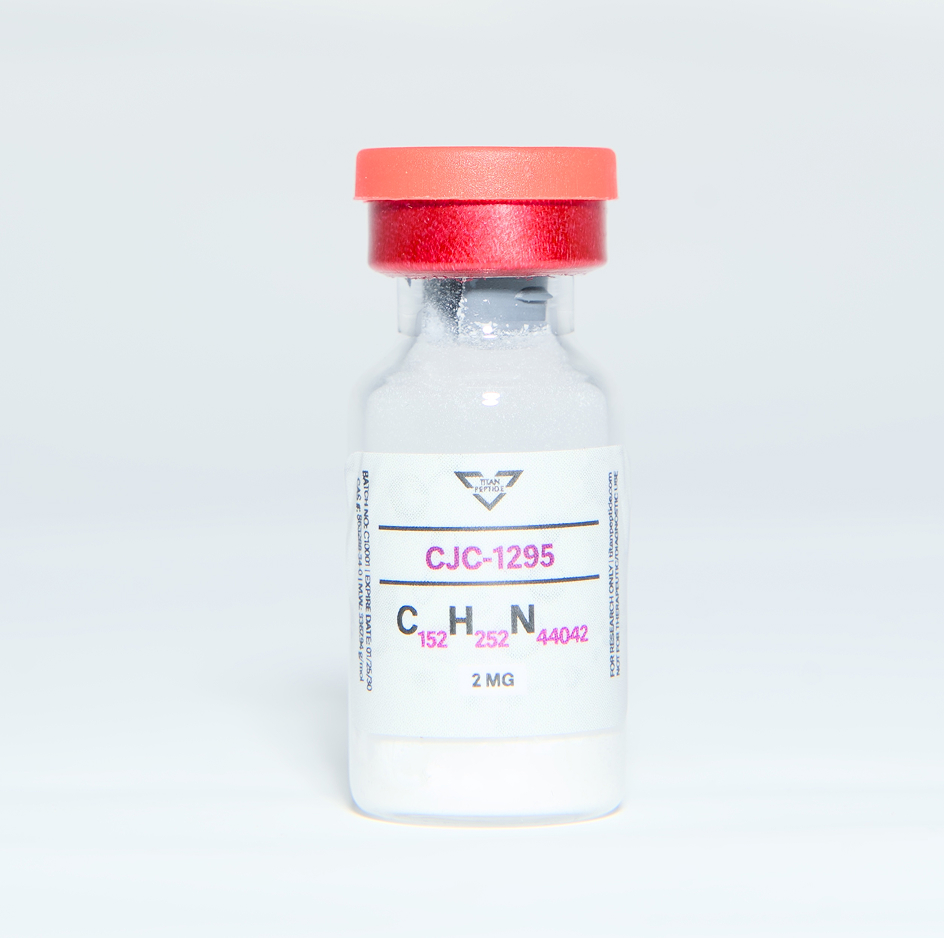

CJC-1295
CJC-1295 is a 30-amino acid peptide analog of GHRH designed to stimulate the release of growth hormone from the anterior pituitary. Unlike MOD GRF (1-29), CJC-1295 contains a drug affinity complex (DAC) that binds to albumin, significantly extending its half-life and duration of action in experimental settings. This prolonged activity allows for sustained growth hormone release rather than short, pulsatile bursts.





A synthetic growth hormone–releasing hormone (GHRH) analog with extended half-life, modeled for laboratory research.
CJC-1295 is a 30-amino acid peptide analog of GHRH designed to stimulate the release of growth hormone from the anterior pituitary. Unlike MOD GRF (1-29), CJC-1295 contains a drug affinity complex (DAC) that binds to albumin, significantly extending its half-life and duration of action in experimental settings. This prolonged activity allows for sustained growth hormone release rather than short, pulsatile bursts.
In research models, CJC-1295 is studied for its effects on metabolism, body composition, recovery, and repair processes. Its extended activity makes it particularly useful for investigating long-term growth hormone modulation without frequent administration.

Titan research and immune system function
Sustained GH Release
Examined for its ability to maintain elevated growth hormone levels over days rather than hours.
Metabolic Function:
Studied for potential effects on fat loss, lean muscle gain, and improved energy metabolism.
Recovery & Repair:
Investigated for supporting muscle and tissue regeneration in injury and stress models.
Aging Research:
Used in experimental protocols aimed at reversing age-related decline in growth hormone secretion.
Comparative GHRH Studies:
Provides a model for comparing short-acting vs. long-acting growth hormone–stimulating peptides.
Titan research and immune system function
DAC-Albumin Binding:
This modification extends half-life to up to 8 days in animal models, reducing dosing frequency.
Anabolic & Metabolic Pathways:
Increases IGF-1 levels in line with GH elevation, influencing protein synthesis and nutrient partitioning.
Tissue Regeneration:
Supports studies on muscle, tendon, and skin repair mechanisms.
(1) Teichman, S. L., et al. (2006). CJC-1295, a long-acting growth hormone-releasing hormone analog, increases growth hormone and IGF-1 in humans. → Found significant increases in GH pulse frequency and IGF-1 levels, peaking after several weeks. [Journal of Clinical Endocrinology & Metabolism, 91(11), 4792–4797]
(2) Ghigo, E., et al. (2001). Pharmacologic GH secretagogues in clinical practice. → Supports the mechanism of GH-releasing hormone analogs, including CJC variants, in elevating GH sustainably.
(3) Rahmani, M., et al. (2007). GH stimulation with CJC-1295: clinical implications and metabolic improvements. → Noted benefits in body composition and IGF-1 increase with non-DAC protocol dosing.
.svg)
The graph illustrates the effect of CJC-1295 (No DAC) on GH/IGF-1 axis activity over a four-week period, using both human and animal data. By Week 1, there is already a measurable increase of 18%, showing that the compound begins to act relatively quickly. By Week 2, the effect climbs to 32%, highlighting a steady upward trend in growth hormone and IGF-1 activity.
By Week 4, the increase reaches 50%, indicating a substantial boost compared to baseline. The pattern suggests that CJC-1295 delivers a progressive, cumulative impact on the GH/IGF-1 axis, with notable gains each week. This makes it a promising candidate for protocols targeting growth and recovery through enhanced hormone signaling.
Form:
Lyophilized Powder
Storage (unreconstituted):
- Store at 2–8 °C (refrigerated), protected from light.
- For long-term storage, keep at –20 °C.
- Avoid repeated freeze–thaw cycles.
Reconstitution:
- Reconstitute with sterile water for injection or 0.9% NaCl immediately prior to use. Use aseptic technique.
Storage (after reconstitution):
- Store at 2–8 °C.
- Use within 7–10 days.
- Discard any unused solution after this period.
- Handle under sterile conditions.
- Do not shake vigorously (may cause peptide denaturation).
- Inspect visually for particulate matter or discoloration before use.
Issued for quality verification of tested material.
Feedback highlighting proven outcomes and reliability.













